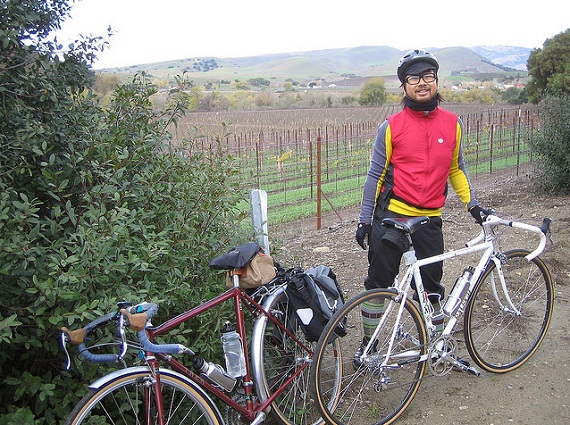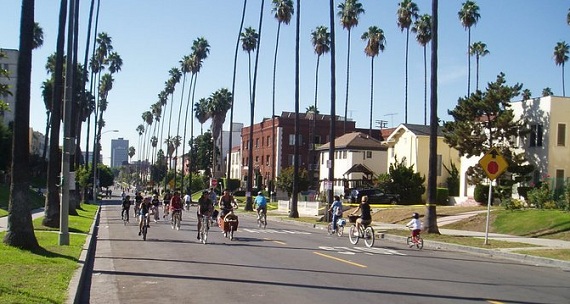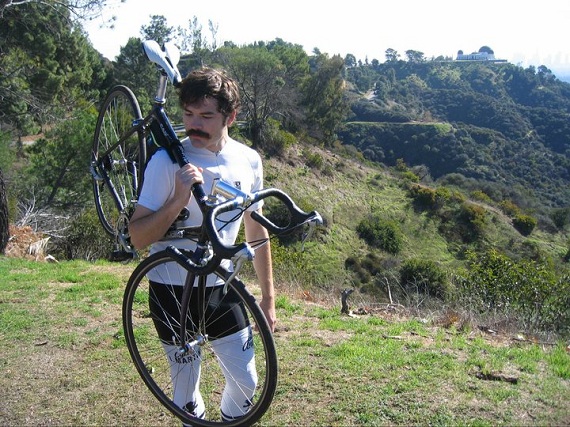Looking at Bike Progress in L.A., from the View of a Journalist
8:03 AM PDT on July 27, 2011
(Angelika Sjostrom is a senior at California State University Northridge where she studies journalism. A recreational bike rider, doing research for the story has inspired a budding interest in cycling culture. Angelika resides in LA's historic Angelino Heights. This is her first contribution to Streetsblog. Any opinions found within are that of the author. - DN)
In a city with a population of four million, the majority of whom commute via car or bus, Los Angeles resident John Vu does not follow the crowd. An avid bicycle rider, he travels his 12-mile commute to work on two wheels. “Riding a bike is an important part of getting around the city for me” said Vu.
Vu, 36, is a living, breathing testament to the social, economic, and health benefits of traveling by bike. “I started cycling in 2006 and haven’t looked back since,” Vu said. Born and raised in Los Angeles, Vu learned to drive a car as a teenager and never entertained the idea of using a bike as his main mode of transportation. That is, until two of his friends convinced him to try it out. “It was definitely an evolutionary process,” Vu said, who started riding for fun and eventually began using his bike to commute to work.
Now, Vu rides his bike to work five days a week (weather permitting) and even uses Twitter to keep statistics of his ride. For example, one Tweet read: “Rush hour Beverly Blvd. to Santa Monica Blvd. ride to work. Least contentious commute ever. Door to desk in 52 minutes.”
“Riding my bike, in most circumstances, is the most practical way for me to get around the city,” Vu said. “Cycling is an amalgam of transportation, healthy activity, and social interaction, which is why I’ve come to love it so much.”
Los Angeles is not typically thought of as the most accommodating city for bicyclists, and indeed, it has a long way to go. Progress is on the horizon, however.
Christopher Kidd, the Assistant Coordinator for the Los Angeles Department of Transportation’s Bicycle Program, is hopeful for the future. “Fortunately for the bicycle community, we have unwavering support from Mayor Villaraigosa and everyone in the mayor’s office,” Kidd said.
Kidd, 29, has personal and professional connections with the bicycle community. An urban planning graduate student at the University of Southern California, Kidd has worked at LADOT for the past year. While the majority of his work is administrative, he is most proud of the work he does for LADOT’s Bike Program blog.
Kidd stressed the impact social media has had on the bicycle movement, especially in terms of generating a dialogue between city officials and the community. “The blog has had an enormous impact on distributing information to Angelinos as a whole,” Kidd said. He continued, “LADOT finally had the realization that they weren’t part of this very progressive conversation and so the blog was born.”
Over the past five years, the bicycle community has become a commanding presence in Los Angeles’ City Planning Office. Bicycle advocacy groups have been rallying together for years, pleading for the safe infrastructure bicyclists want and deserve.
The most recent victory the bicycle community is celebrating is the “Give Me 3” legislation making it on the State Legislature agenda. Formally known as S.B. 910, the bill requires a three-foot passing distance with a maximum speed differential of fifteen miles per hour between motorists and cyclists—a safety measure not yet written in the California Vehicle Code.
The bill, drafted by Long Beach Senator Alan Lowenthal, began with a bicycle advocacy campaign last summer that was endorsed by Mayor Villaraigosa, LADOT, the Los Angeles County Bicycle Coalition (LACBC), the Los Angeles Police Department, and grassroots group Midnight Ridazz.“This bill will legally reaffirm a bicyclist’s rights to the road. If passed at the state level, it will also offer a great opportunity to add bicycle safety education to the Department of Motor Vehicle’s agenda,” Kidd said. “We want bicycle safety awareness on both ends of the spectrum; there needs to be an understood respect between drivers and riders.”
Kidd also cited the LAPD as an important presence in rallying support for the bill, as well as supporting the bicycle community in general. “Sergeant David Krumer, who heads up LAPD’s Bicycle Patrol Unit, has been an indispensable voice in the transportation conversation,” Kidd said.
The LAPD Bicycle Task Force, formed specifically under Chief of Police Charlie Beck’s command, works closely with LADOT and LACBC to further the relationship between the police department and the community.
Bobby Gadda, the Bike Valet Coordinater at the LACBC and President of the Board of Directors for CicLAvia, echoed Kidd’s praise of the LAPD.
“Sgt. Krumer has really championed the importance of a dialogue between the community, the city, and all the departments involved in bike infrastructure,” Gadda said. “The LAPD is finally starting to get the message out about bicycling being a legitimate form of transportation on par with buses and the Metro Rail.”
CicLAvia, which had its first official event in 2010, is Gadda’s pride and joy. “I went to Bogotá, Colombia a few years ago and was blown away by their Ciclovía event. After that trip, I moved down to Los Angeles from Portland, ditched my car, and have been involved in bicycle advocacy ever since,” Gadda said.
Los Angeles’ version of the event shuts down seven-and-a-half miles of the city’s streets, from the Bicycle District on Melrose and Heliotrope, through Macarthur Park, Downtown Los Angeles, and finally ends in Hollenbeck Park. Gadda worked closely with LACBC, LADOT, and LAPD to organize the event.
“Three years ago, a committee was started to discuss different routes and how to get the city involved, and it really didn’t take long to get the attention of the Mayor’s office,” Gadda said. The event, which took place this year on April 10, was by and large a huge success.
The goal of CicLAvia is to provide a safe, welcoming environment on the city streets for bicyclists, skateboarders, rollerbladers, walkers, runners—basically, as Gadda put it, “anything without a motor.”
Rob Flate, 31, of Silver Lake, was one of the many enthusiastic CicLAvia participants. “It was really interesting seeing the normally busy LA streets with no cars on them. I grew up here and have never seen anything like that. It was like a scene out of Vanilla Sky,” said Flate.
Flate continued singing praises of the event, saying, “It’s really nice to see people brought together over a common interest, especially one as beneficial and simple as riding a bike. At CicLAvia, you had this huge range of people across the spectrum of ethnicities and ages, all in one place and sharing a common reality.”
In Los Angeles, where the city’s streets are constantly filled with dense traffic, CicLAvia was widely received by Angelino’s as a positive statement that emphasized the change urban transportation is experiencing.
Gadda’s work with LACBC extends far beyond CicLAvia, however. He heads up LACBC’s Bike Wrangler program which reclaims abandoned bicycles throughout the county, fixes them, and redistributes the bikes to low-income communities.
The program is funded by the RENEW grant, part of Los Angeles County Department of Public Health’s program to reduce obesity and promote healthy activity throughout the county. The RENEW grant consists of money from President Obama’s
American Recovery and Reinvestment Act stimulus package introduced in 2009. The RENEW grant extends its reach far into the bicycle community. Marissa Christiansen, who is the South Bay Initiative Director for LACBC, has oversight for
RENEW- funded projects in Long Beach and surrounding municipalities.
“The grant perfectly supports the advocacy goals of LACBC in that RENEW’s goal is improving community health and, in the case of programs like the Bike Wrangler, the South Bay Bicycle Master Plan, and Safe Routes to School, the goals will be achieved through promoting active transportation,” Christiansen said.
Christiansen, who began her work with the South Bay Bicycle Coalition (SBCC) and teamed up with LACBC, is positive about the future of bicycle infrastructure and urban planning despite the obstacles facing the bicycle community.
“In general, our cities have long been designed around the automobile, so convincing the stewards of our cities that they should start doing things differently is always a challenge,” Christiansen said.
On March 8, Christiansen and other advocacy representatives went to Capitol Hill for the National Bike Summit where they lobbied for a prioritization of federal funding for bicycle infrastructure on a national level.
While the summit was a positive conversation between advocacy groups and politicians, Christiansen said that some offices did indeed warn them that, in considering the national economic climate, many programs are at risk of being on the chopping block. “This has proven to be a very real concern,” Christiansen said. “As we’ve seen in just the past couple of weeks, unspent Safe Routes to School and Transportation Enhancement funding is at risk of being inaccessible as a result of the current recession.”
Fortunately, however, Christiansen thinks that since bicycle infrastructure has become a prevalent feature in renovating urban planning throughout the state, California still have much progress to look forward to.
Christiansen emphasized her positivity, saying, “With all the momentum building about bikeability, convincing cities that they should be more proactive in creating an equitable transportation system has become a different conversation than it would be if we were pushing them to forge uncharted waters.”
In 2010, the Los Angeles City Council adopted the Los Angeles Bike Plan that calls for the implementation of over 1,600 miles of bicycle infrastructure over a 30-year period.
Kidd, who has been following developments in the plan for LADOT’s blog, said it is essentially “a backbone network for bicyclists so that at any given time, you would be no less than one mile away from some kind of bikeway.”
The LA Bike Plan, which is city-wide and funded in part by L.A. County's Measure R, includes a wide range of projects over the 30-year span. Jennifer Klausner, executive director of LACBC, said that the new plan, which calls for the implementation of 40 miles of bikeways each year, will quadruple what is currently being added.
Each month, a committee called the Bike Plan Implementation Team (BPIT) meets to discuss challenges facing the LA Bike Plan and how to solve those issues. The largest source of contention between the BPIT, LADOT, and City Planning is conducting Environmental Impact Reports (EIR) for proposed road conversions.
“The city is very careful about ridding itself of liability, and conducting EIR’s on proposed projects is one way they cover themselves,” Kidd said. The EIR’s are a nuisance to both the BPIT and the bicycle community because it will delay projects by at least a year as well as expend funds on conducting the reviews.
However, Kidd emphasized, “As frustrating as the delay EIR’s cause is to bicycle advocates, it’s a necessary step in improving the city’s infrastructure.”
The hard work that is being championed by the LACBC, the LADOT Bike Program, the LAPD, and countless others involved in enhancing the city’s infrastructure is not overlooked by cycling Angelino’s.
John Vu, whose shift from commuting via car to commuting via bicycle in 2006 changed his life for the better, is optimistic about the work the city is doing to improve the streets.
“I think what helps is that, over the past five or so years, there has been this huge cultural shift where bicycling is finally on the commuter’s radar,” Vu said. “Cycling is no longer a male- dominated, uppity sport. With the internet, cycling has gotten a significant boost and people are finally seeing that it’s a fun, social thing to do, and it also gets you from point A to point B for free.”
The fact that the bicycle community has been generating a louder voice backed by city agencies and, perhaps most importantly, Mayor Villaraigosa, is a testament to the shift urban planning is taking to incorporate bicycling in city infrastructure.
“Our goal is to make it so that there is no such thing as a bicycle community,” Kidd said. “By that I mean, there is no such thing as a community of people with driver’s licenses. There is no need for drivers to rally together and plea for rights from the city. That is the goal of LACBC, LADOT Bike Program, and all the other advocacy programs out there: to make bicycling ubiquitous in Los Angeles.”
Stay in touch
Sign up for our free newsletter
More from Streetsblog Los Angeles
Metro Committee Approves 710 Freeway Plan with Reduced Widening and “No Known Displacements”
Metro's new 710 Freeway plan is definitely multimodal, definitely adds new freeway lanes, and probably won't demolish any homes or businesses
Automated Enforcement Coming Soon to a Bus Lane Near You
Metro is already installing on-bus cameras. Soon comes testing, outreach, then warning tickets. Wilshire/5th/6th and La Brea will be the first bus routes in the bus lane enforcement program.







